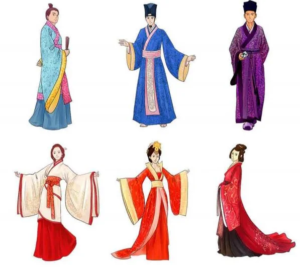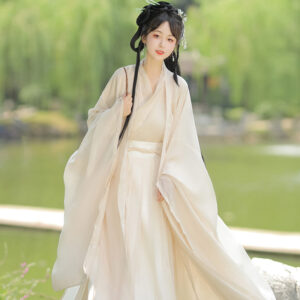

Qing Dynasty Hanfu patterns were rich in symbolism, reflecting social status, cultural beliefs, and the values of the time. Each motif and design carried deep meanings derived from ancient Chinese traditions and philosophies. Here’s a closer look at the significance of these patterns:
1. Imperial Symbols
- Dragons: A predominant motif in imperial attire, dragons symbolize power, authority, and imperial sovereignty. Only the emperor and his family were allowed to wear garments adorned with five-clawed dragons, emphasizing their supreme status. The dragon often appeared amidst clouds, representing celestial power and divine right to rule.
- Phoenixes: Often paired with dragons, the phoenix represents grace, virtue, and beauty. This combination symbolizes a harmonious balance between yin and yang, particularly in wedding attire, where it embodies wishes for a balanced and blissful marriage.
2. Color Significance
- Yellow: Exclusively reserved for the emperor, yellow represents power, royalty, and prosperity. Its use in Hanfu underscored the emperor’s supreme status and was strictly regulated to maintain social hierarchy.
- Red: A dominant color in Chinese culture, red symbolizes good fortune and joy. It is often used in festive and wedding attire to convey celebration and happiness.
- Floral Patterns: Common motifs like lotus flowers or peonies symbolized purity, wealth, and harmony with nature. These patterns were frequently found in civilian attire, reflecting the wearer’s connection to cultural values.
3. Social Stratification
- Class Indicators: The intricacy of patterns and the quality of fabrics used in Hanfu varied significantly among social classes. Imperial Hanfu featured elaborate designs with luxurious silk, while commoners wore simpler styles with less extravagant motifs. This visual distinction reinforced the rigid social hierarchy of Qing society.
- Prohibitions on Motifs: Certain colors and symbols were legally restricted for lower classes. For instance, commoners could not wear dragon motifs or the color yellow, maintaining clear visual boundaries between different social strata.
4. Cultural Beliefs
- Confucian Values: The designs often reflected Confucian ideals of order and hierarchy. The use of specific patterns conveyed respect for tradition and social norms.
- Natural Elements: Patterns inspired by nature—such as clouds, waves, and flowers—symbolized harmony with the universe. These motifs highlighted the importance of nature in Chinese philosophy.
5. Seasonal Patterns
- Seasonal Symbolism: Certain motifs were associated with seasons; for example, plum blossoms represented winter resilience while peonies symbolized spring’s arrival. This seasonal representation connected wearers to the natural cycle of life.
6. Mythological Influences
- Legendary Creatures: Besides dragons and phoenixes, other mythological creatures like qilin (a hooved chimerical creature) appeared in Hanfu designs, symbolizing good fortune and protection.
- Folklore Motifs: Patterns depicting scenes from Chinese mythology or folklore added layers of meaning to garments, reflecting cultural narratives that resonated with society.
7. Regional Variations
- Local Patterns: Different regions incorporated unique local motifs into their Hanfu designs based on local customs and beliefs. This regional diversity enriched the symbolism associated with patterns across different areas of China.
8. Ceremonial Significance
- Ritualistic Designs: Certain patterns were reserved for ceremonial garments worn during important events such as weddings or festivals. These designs often included auspicious symbols meant to bring good luck or blessings to the wearer.
9. Gender Differences
- Masculine vs. Feminine Motifs: Patterns often differed by gender; for instance, floral designs were more common in women’s Hanfu while geometric shapes might be favored in men’s attire. This differentiation reflected societal views on gender roles.
10. Evolution Over Time
- Changing Symbolism: As societal values evolved through different dynasties, so did the symbolism associated with patterns in Hanfu. The Qing Dynasty saw shifts influenced by both internal changes and external interactions that reshaped traditional meanings.
Summary Table: Symbolism in Qing Dynasty Hanfu Patterns
| Pattern Type | Symbolism |
|---|---|
| Dragons | Power and imperial authority; exclusive to emperors |
| Phoenixes | Grace and virtue; symbolizes balance in marriage |
| Yellow | Royalty and prosperity; reserved for the emperor |
| Red | Good fortune and joy; prevalent in festive attire |
| Floral Patterns | Purity, wealth, and harmony with nature; common in civilian clothing |
| Class Indicators | Intricacy of designs reflects social status; legal restrictions on certain motifs for lower classes |
| Seasonal Patterns | Connects wearers to natural cycles; seasonal motifs represent resilience or renewal |
| Mythological Influences | Legendary creatures symbolize good fortune; folklore motifs reflect cultural narratives |
| Regional Variations | Local customs influence unique motifs; regional diversity enriches symbolism |
| Ceremonial Significance | Ritualistic designs reserved for important events; auspicious symbols bring blessings |
| Gender Differences | Differentiation in patterns reflects societal views on gender roles |
| Evolution Over Time | Changing symbolism influenced by societal values; adaptations reflect historical contexts |
Conclusion
The patterns found in Qing Dynasty Hanfu were not merely decorative but served as powerful symbols reflecting social status, cultural beliefs, and philosophical values. Through intricate designs and meaningful motifs, Hanfu conveyed messages about identity, hierarchy, and tradition within Qing society. Each garment told a story that connected the wearer to a rich cultural heritage while reinforcing societal norms.
Share this post
Recent Posts


What were the key features of Hanfu during the Tang Dynasty?

How did Hanfu styles vary during different Chinese dynasties?

What accessories are typically worn with Hanfu?

How do you choose the right Hanfu for different seasons?

Newsletter
Popular Categories
Related Post
Sed aliquam, tortor et sodales malesuada, lorem leo luctus tellus, quis interdum eros nibh in nunc. Cras dignissim malesuada, lorem leo luctus

What are the winter hanfu called?

What were the key features of Hanfu during the Tang Dynasty?

How did Hanfu styles vary during different Chinese dynasties?


